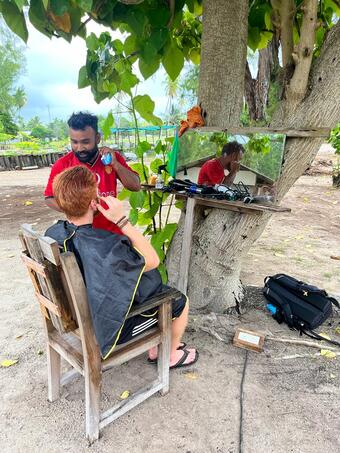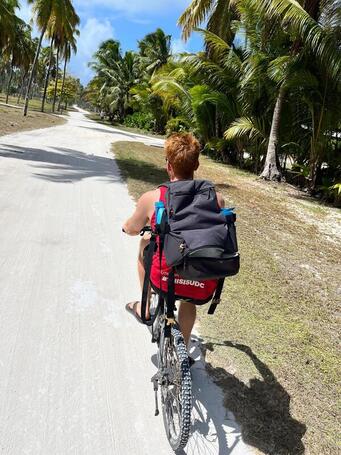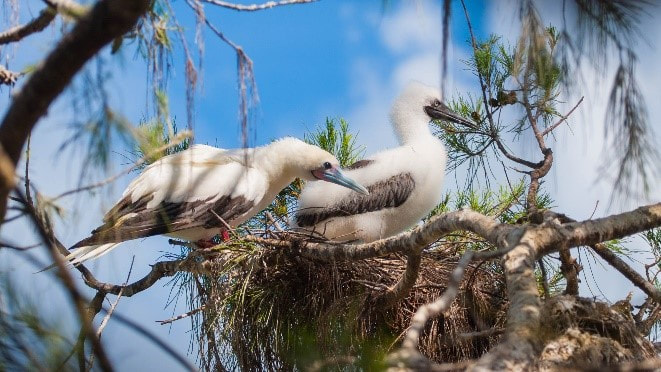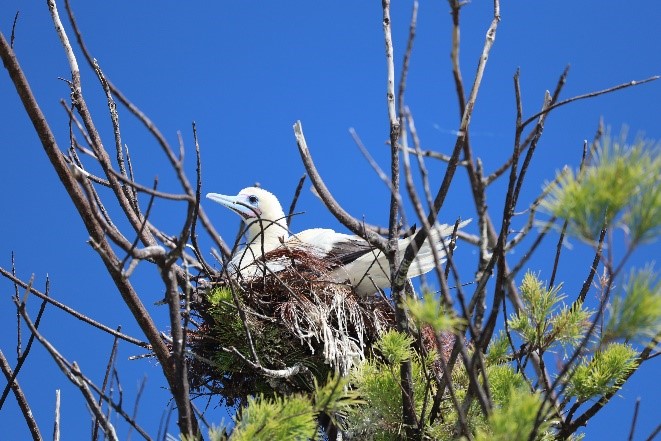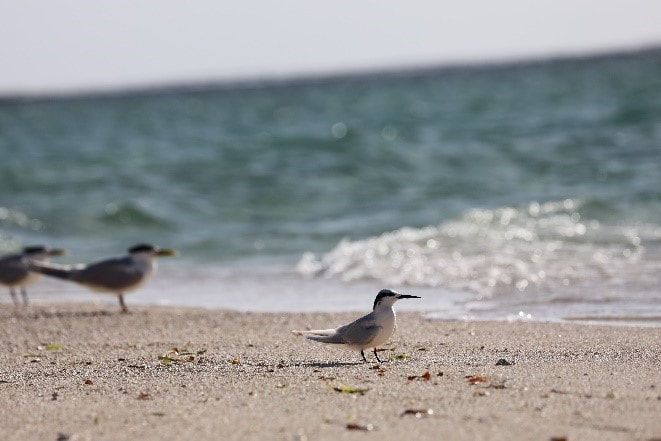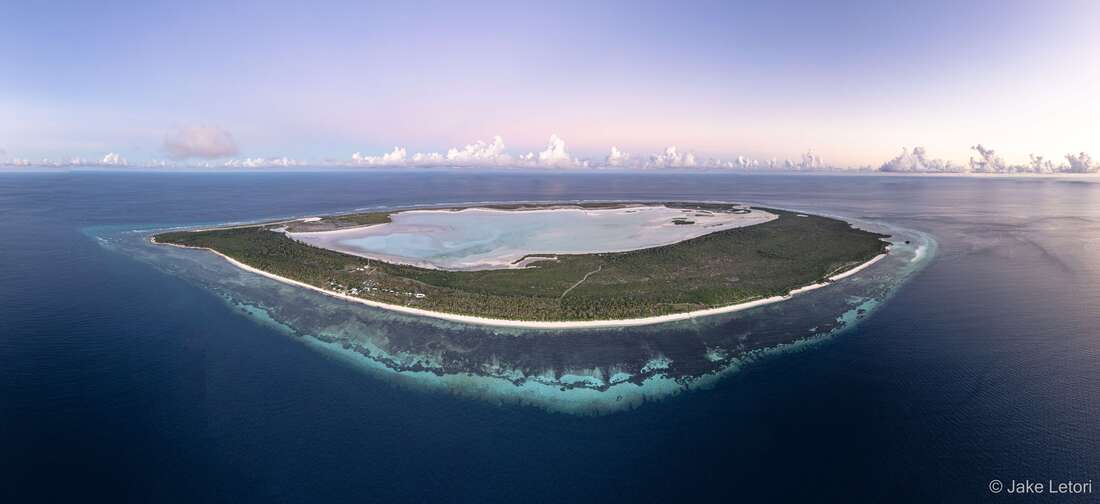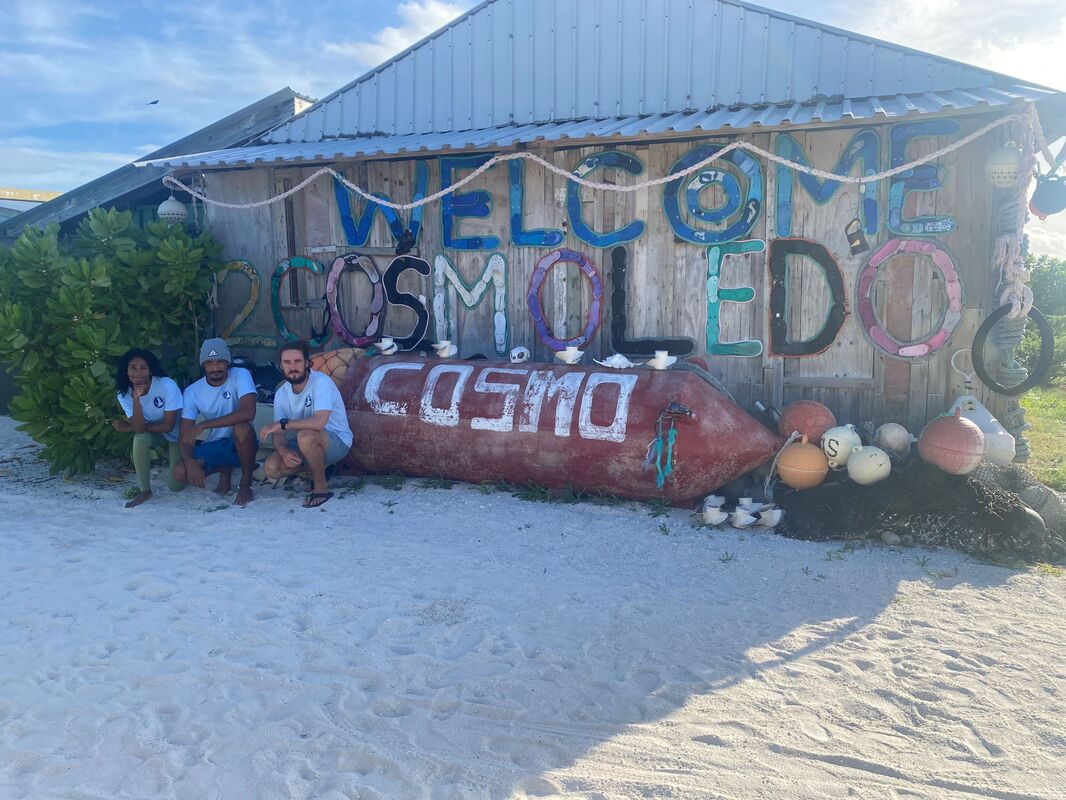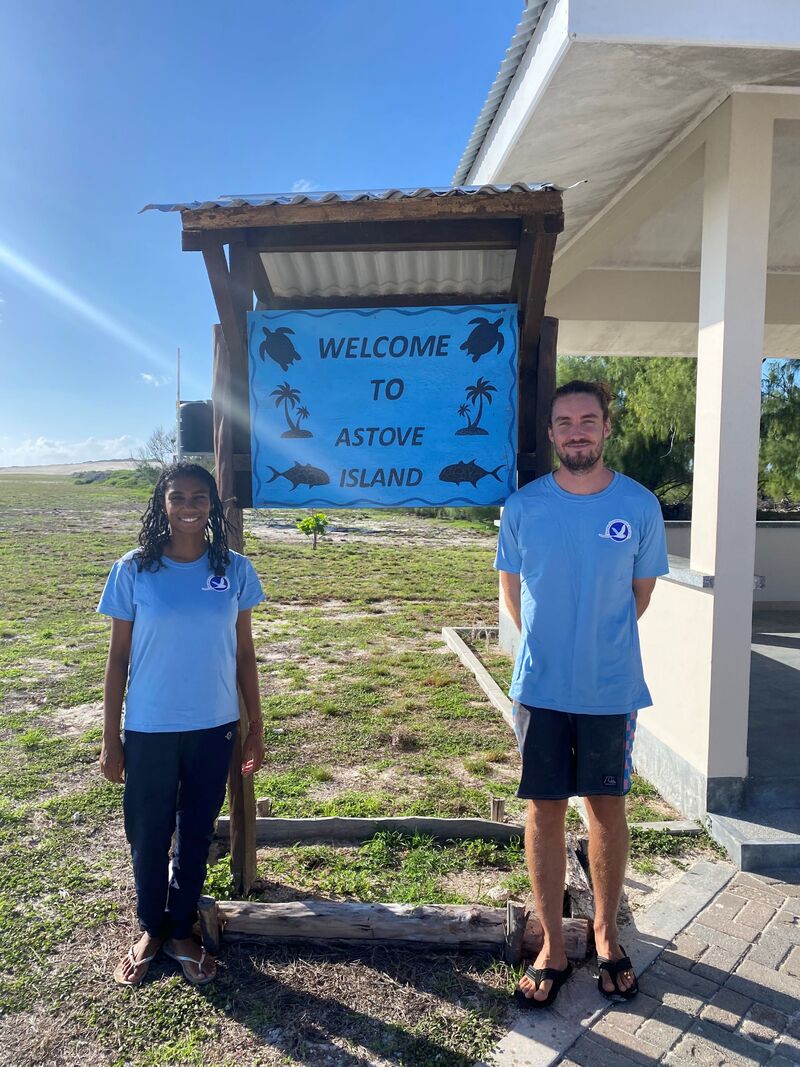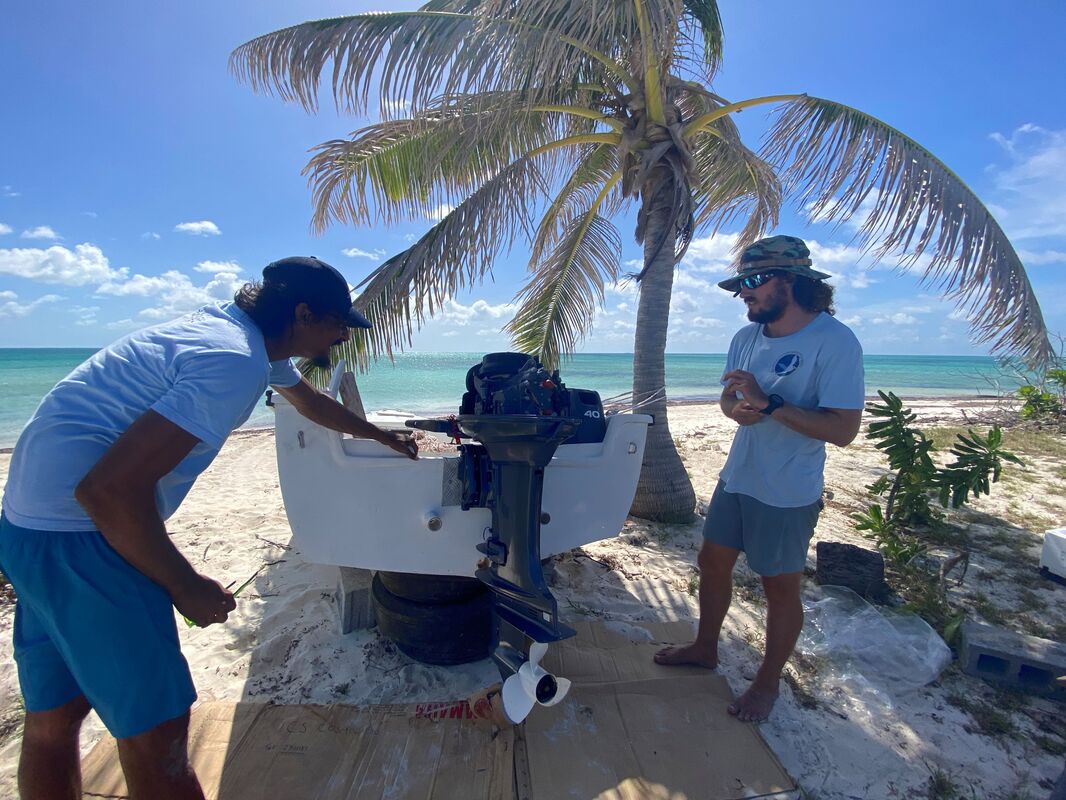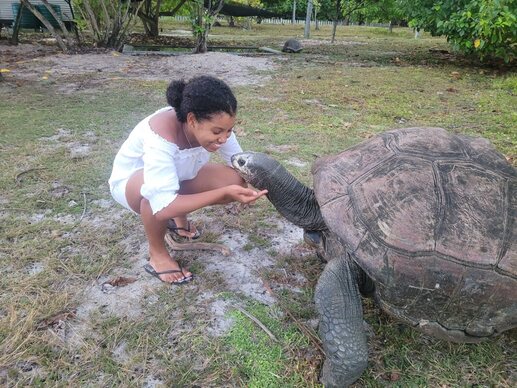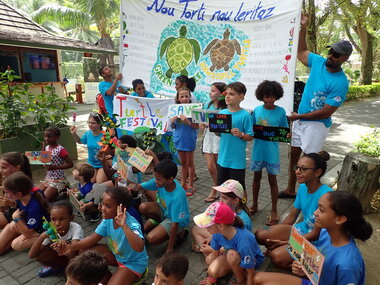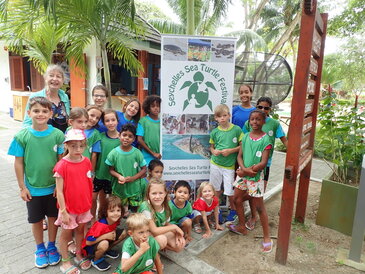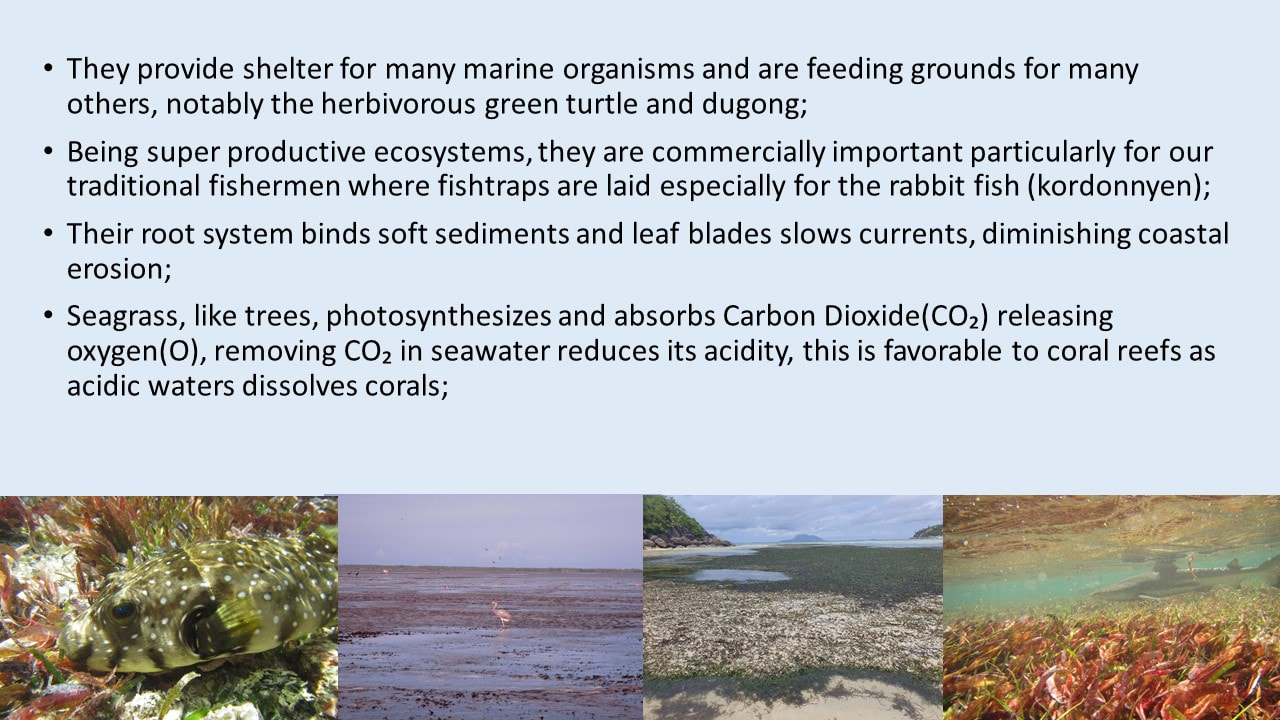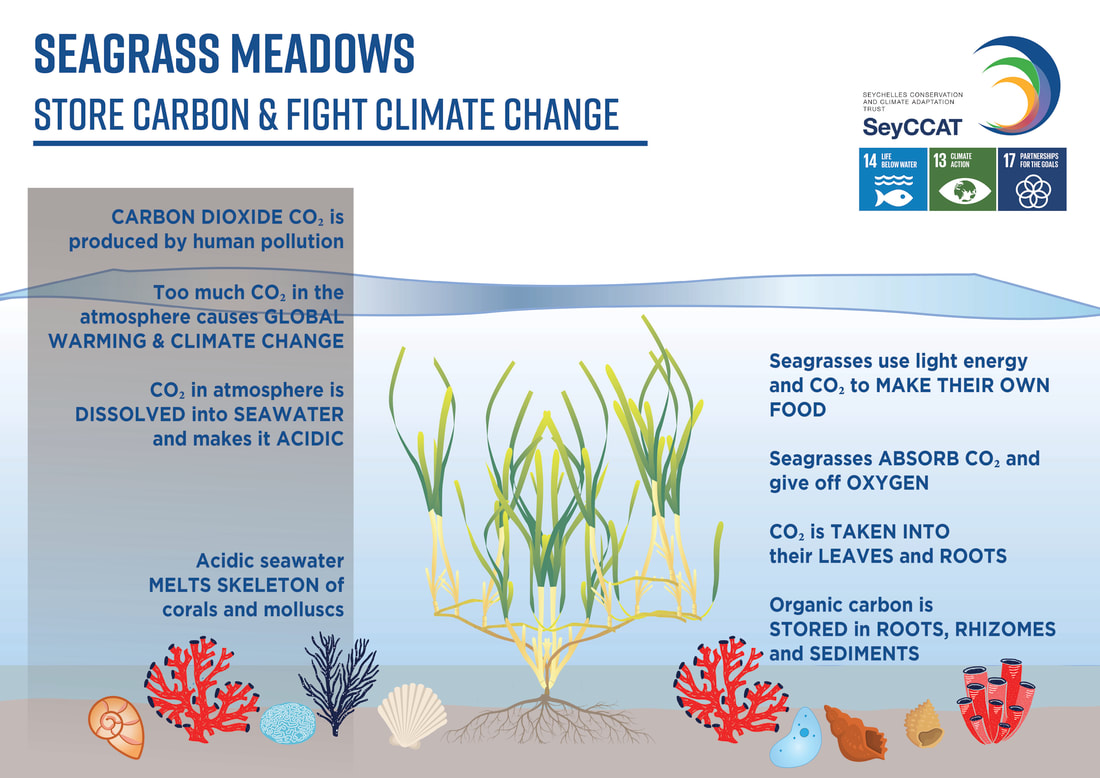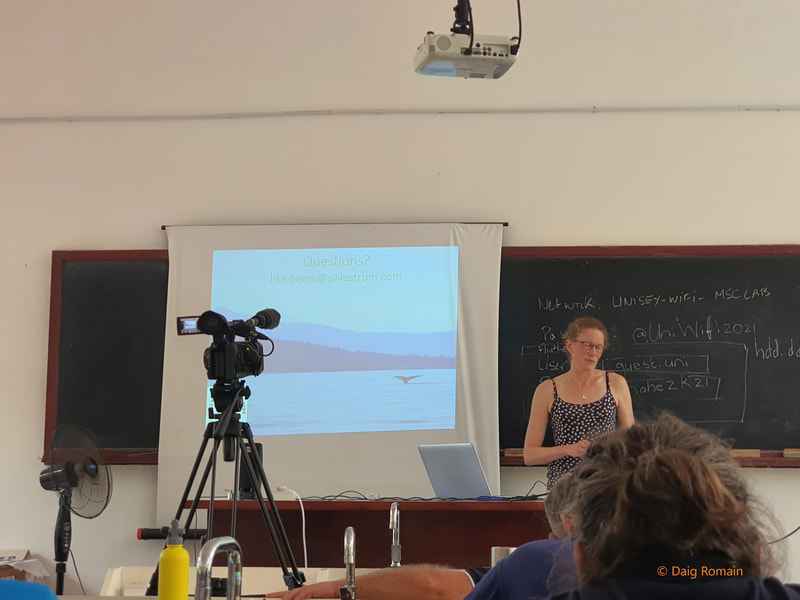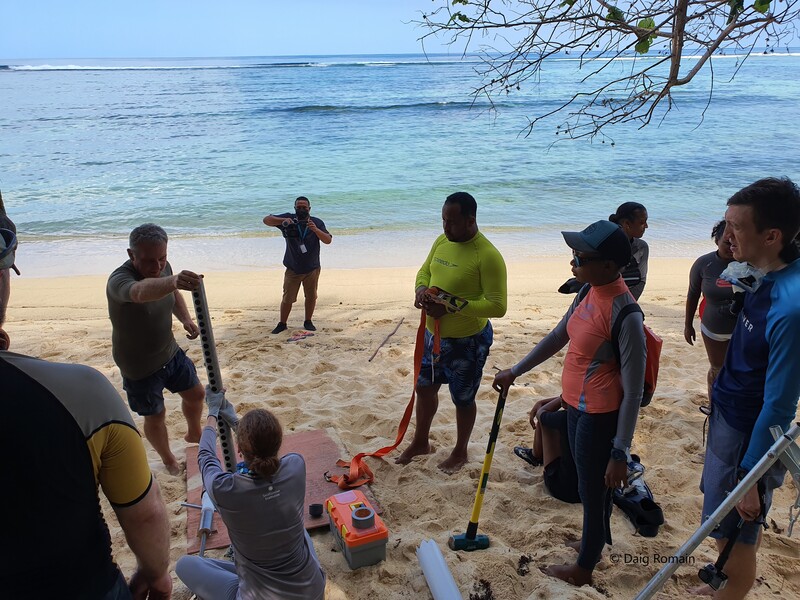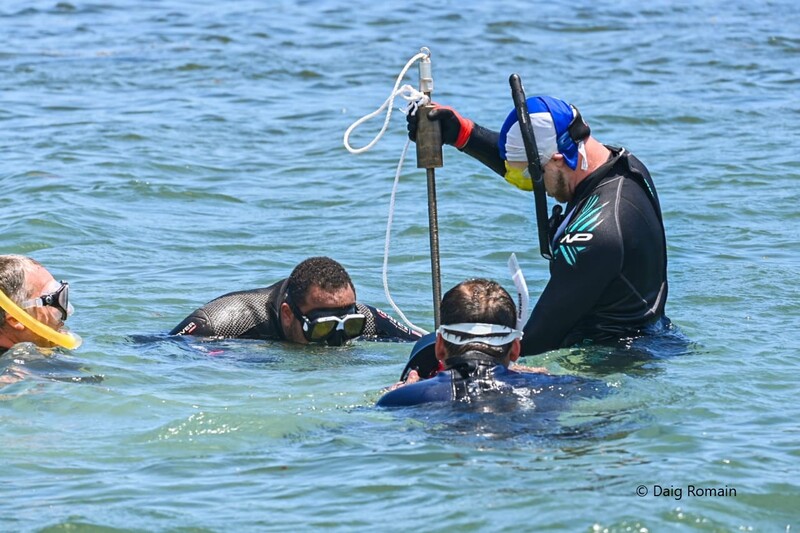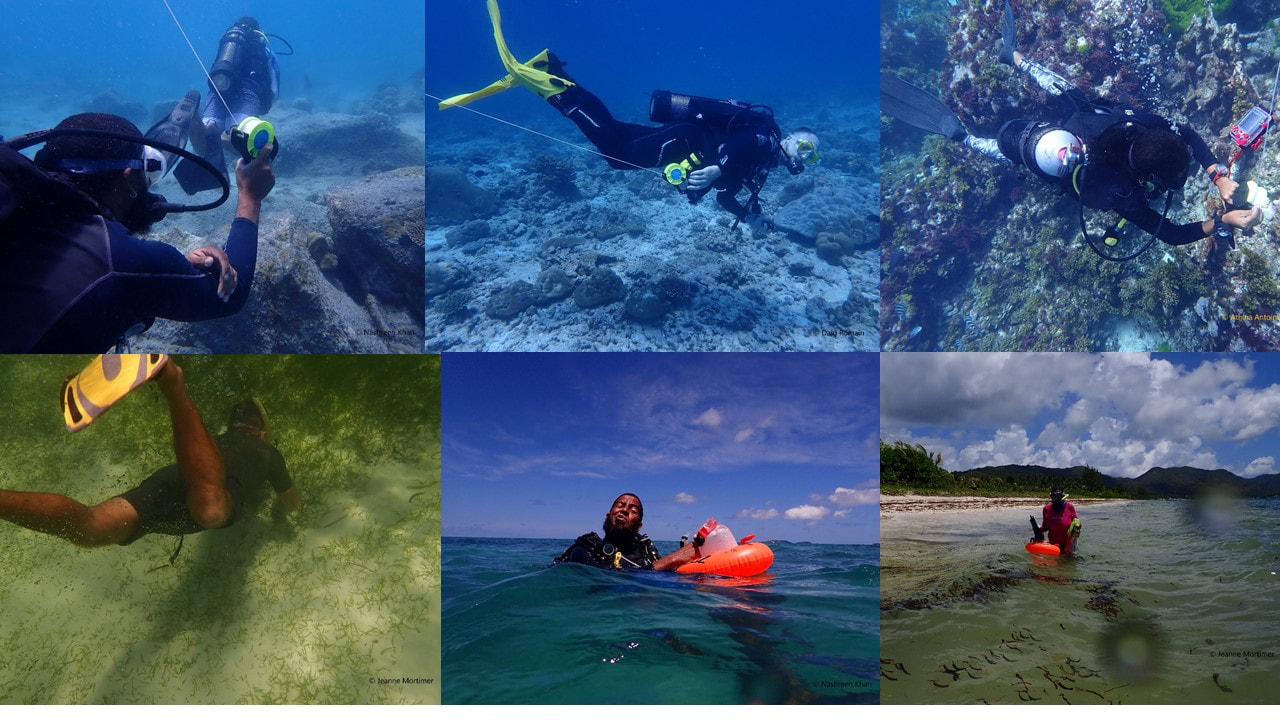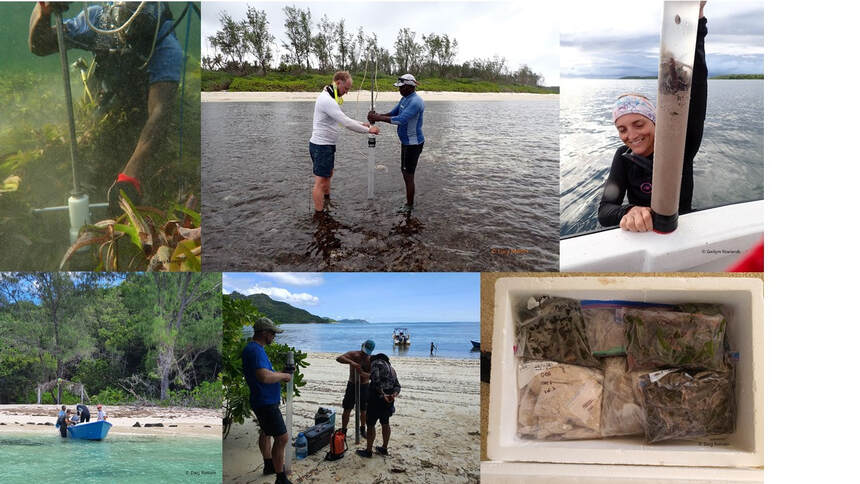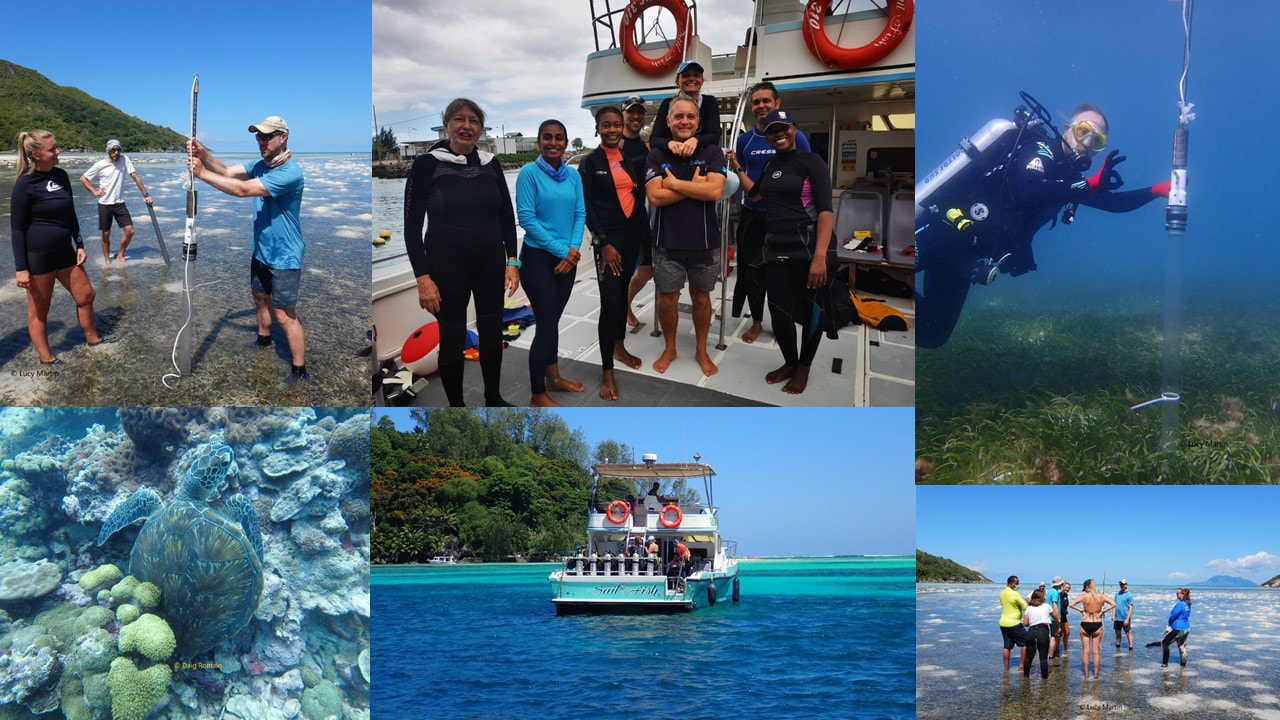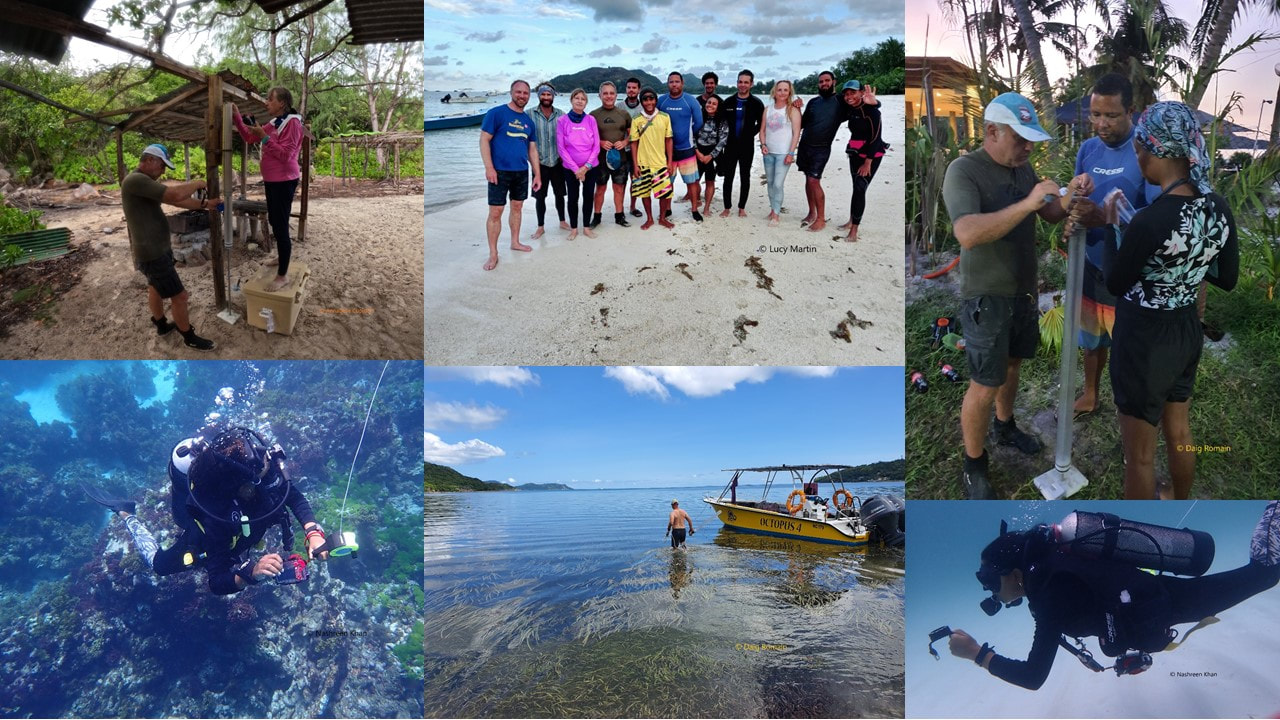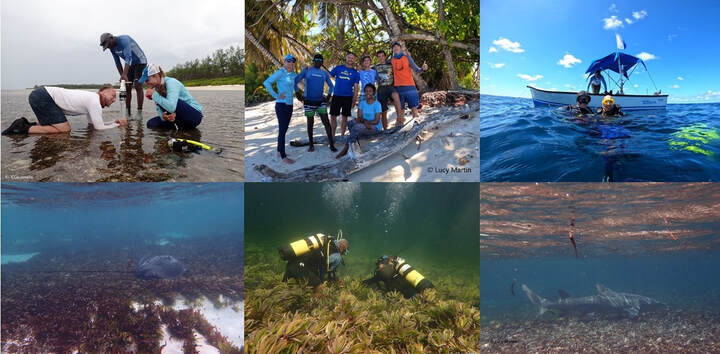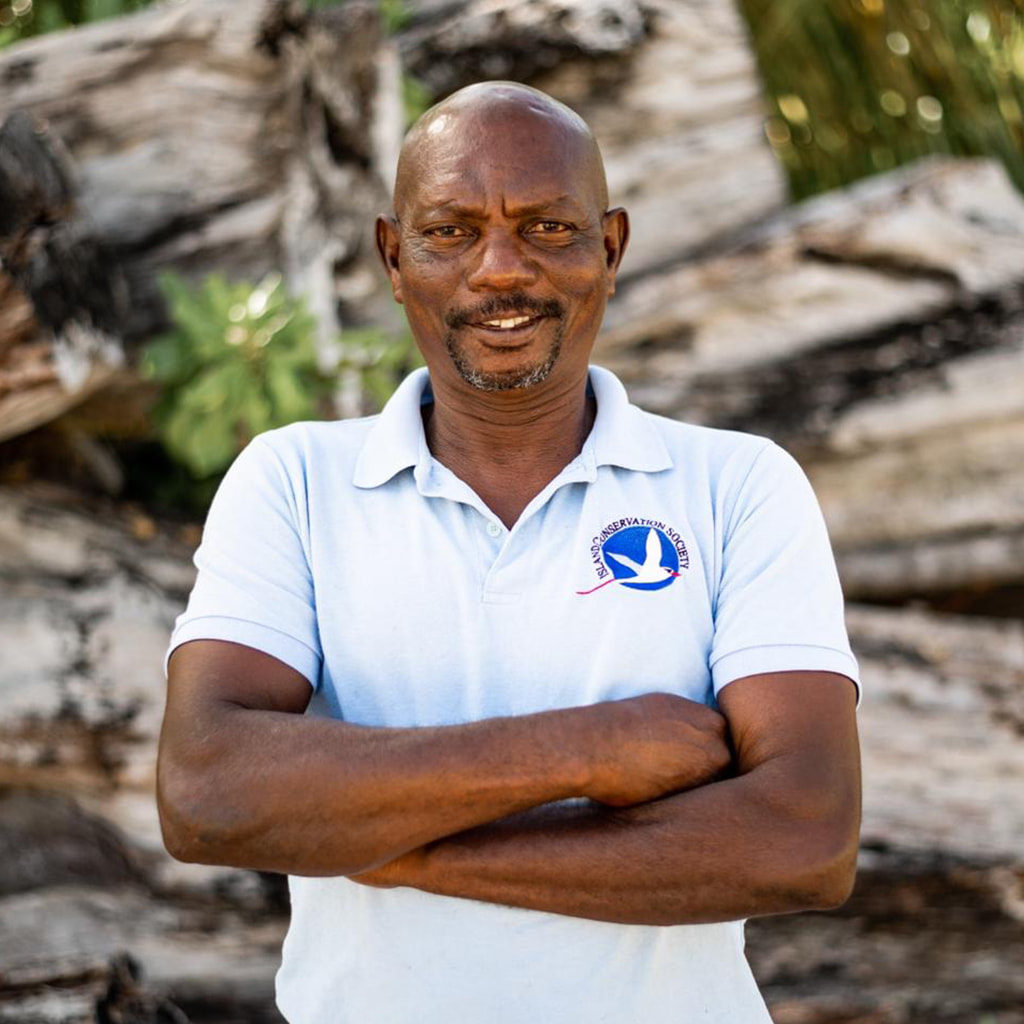|
Spending nine weeks on Aride Island was an extraordinary, once-in-a-lifetime experience that I will always cherish. From the moment I arrived, I was awed by the island's untouched beauty and the warm welcome from the conservation team. As part of my master’s research project, I had the unique opportunity to study wild Aldabra giant tortoises in their natural habitats and witness firsthand their role as island ecosystem engineers. My project, "Evaluating the Role of Aldabra Giant Tortoises in Island Ecosystem Restoration: Ecological Impacts on Seed Dispersal and Germination Success," was incredibly rewarding, providing me with many new skills and experiences within the field of tropical island conservation.
Most of my days were spent tracking and observing the tortoises, often from behind trees or crouched in tall grass, as I learned about their feeding behaviors and seed dispersal patterns. A less glamorous but essential part of my fieldwork involved examining tortoise droppings for fruit seeds, which I then planted to observe their germination success. Watching the first seedlings sprout was incredibly rewarding. Our research revealed that the tortoises’ movements across the island significantly contribute to seed dispersal, enhancing plant diversity and aiding in the regeneration of native and endemic plants. These findings show us the importance of reintroducing giant tortoises to islands where they had previously gone extinct. My time on Aride Island was unforgettable and deepened my passion for becoming a wildlife conservationist. In our spare time, we enjoyed walking barefoot, hiking the rocky hills, and snorkeling above the coral reef. Living with minimal internet access and without modern luxuries allowed us to fully immerse ourselves in the natural environment. The lack of daily comforts, such as consistent access to drinking water, reminded us of global issues many communities face and taught us how to adapt to remote conditions. To future volunteers and researchers, I offer this advice: embrace every moment in this tropical paradise. There is nowhere else you’ll experience such pristine nature, with thousands of birds and reptiles always keeping you company.
0 Comments
Recently, we had a visit from Jo Lilicrap, one of our volunteers in 1991, on Aride Island Nature Reserve. This is what she wrote: "I loved being on the island from my first day there, despite the relative hardships of life on Aride. I didn’t leave the island much during my time there, so we relied on the boatmen to buy our supplies every week, and we could also pick and eat fruits and vegetables grown on the island. We were also fortunate that Ogilvey fished regularly and cooked us gorgeous Creole fish and other #Seychelles dishes. If the boat was going to #Praslin, we would get up early to pick fruit and vegetables to sell—I specifically remember picking chillis, a job I didn’t particularly enjoy. Another job I disliked was hand washing bed sheets with well water, something I was expecting to relive when I visited in April this year, and which I happily avoided! This time round, it also felt like luxury to have a flushing toilet, shower, fridge, and ceiling fan. Something we had in 1991 that is not available today was an ‘oven’ which could be placed over the stove flame—we regularly cooked cakes and homemade pizza; talking to the staff on Aride, I think it’s something they would appreciate having! Other differences were the introduction of tortoises and magpie robins, a fuller canopy on the plateau and a few more buildings. Despite the differences, so much felt familiar when we arrived on Aride. The beauty of the beach still amazed, the heat and humidity still made everyday tasks tiring, the mosquitoes still left their mark, and the noise of the waves and birds still lulled us to sleep. I left the island feeling very relaxed and knowing that Aride is such a special place that must be protected for future generations. I hope I will be able to return soon to witness the ongoing work there." Napoleon Wrasse (Cheilinus undulates) is one of those fish that once encountered you can never forget. This is mainly on account of the sheer size of this gentle giant which can reach 230 cm and can weigh as much as 190 kilograms. It is also a beautiful fish, with scales of a myriad of colours from green, mixed up with blue, and a tinge of yellow and purple close to its eyes resembling eyelashes. “Madanm Tonbe” or “Aya Zerar” in Creole is also called different names in different countries such as Maori Wrasse or the Humphead Wrasse. The latter is on account of the hump above its head which protrudes more as the fish matures and is said to look like the hat worn by the French revolutionary army led by Napoleon Bonaparte.
“The Napoleon Wrasse is a slow-growing fish which makes it naturally rare. However, it plays an important role in the ecosystem as they feed on predatory species such as thorns-of-crowns, and therefore allowing a healthier ecosystem to thrive,” states Gregory Berke, the Director of Conservation and Science at the Island Conservation Society (ICS). These attributes of size, shape and colour have made this species from the Wrasse family, also called Labridae, a fishermen’s prized catch in the Indo-Pacific region. The frenzy to catch the biggest wrasse in the world led to the conservation status of this species being upgraded in 2004 by the International Union for Conservation of Nature (IUCN) from vulnerable to endangered. Additionally, the Convention on International Trade in Endangered Species of Wild Fauna and Flora (CITES) also called for more strenuous regulations against trading of Napoleon Wrasse as displays in aquariums. Since then, several of the 50 countries from the East Coast of Africa to the Pacific where the Napoleon Wrasse could be found have introduced new regulations to protect this endangered species. Such global concern in the “King of the Reef” has yet to reach Seychelles were the species is not protected or subject to fishery regulations. This is in spite that the “Madanm Tonbe” or “Aya Zerar” is rarely seen or caught around the Inner Islands. “We would caution fishermen if they ever catch a Napoleon Wrasse to release it. It's a majestic fish that is worth the next photo on social media, but being an endangered species, this could also be the last photo of the fish,” states Berke. 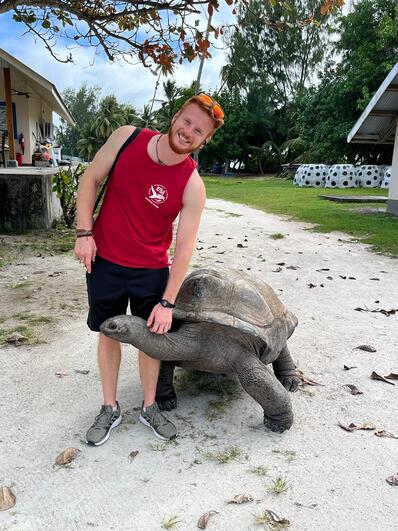 My stay on Desroches Island as a volunteer for ICS was a delight. I learned what the necessary conservation work on a remote island is like. The importance of an organisation that keeps track of different species and their breeding behavior is tremendous. After a learning phase I was able, to contribute my part in the weekly tasks of the team. I conducted turtle patrol to determine, if Green turtles had came to the beach during the night to lay their eggs. I also helped collecting data about the number of different sea birds and their behavior as well. I am grateful, that organisations like ICS invest time and energy in protecting endangered species, like the beautiful Wedge-tailed shearwater, whom a regularly visit to their nests at nightfall became one of my favorite activities. I also learned a lot about tortoises and their behavior since another one of my tasks was feeding and caring for the hatchlings and juveniles in the sanctuary. On these occasions, I could interact with the visiting guests. I have rarely seen creatures as lovely as these little fellows, which made the "work" a real joy. However, the sheer amount of tortoises in the juvenile pen made the food collection a challenging task; unfortunately tortoises do not like palm leaves! I even witnessed a tortoise laying eggs, which is a very rare sight. Sadly, for the safety of the hatchlings we had to move the nest, because she laid in the middle of the road. But my team was sure that the eggs would survive the move. I definitely got sensitized in regard of my behavior as a consumer of one way plastic packages and bottles, when we did the beach cleanup together with a group of other people from the island. That time, we collected a jaw-dropping 183 kilos of waste, which is a huge number, especially knowing that next month the beach will again be polluted. My report would not be complete, if I would not mention the few downsides the live on such a remote island brings with it. I learned what it means, to live with almost no internet and to be dependent on the materials available on the island. I like to think of this as part of the experience but it should not be underestimated. Besides that, I was very happy with the accommodation of course and the delicious meals I could enjoy every day. I also made some amazing friends and spend a wonderful time with them. I will definitely not forget my time on Desroches. Thank you everyone! Peter The Island Conservation Society (ICS) is an NGO which has the mandate to conserve and monitor the dynamic and vulnerable island ecosystems of six of the Seychelles Inner and Outer Island group, namely, Alphonse, Aride, Cosmoledo, Desroches, Farquhar and Silhouette. Each Conservation centre has a small team of dedicated and experienced conservationists that work with the Island Conservation Society Head Office, Island Development Company (IDC) and tourism establishments to achieve their collective conservation goals.
The Alphonse Island group is comprised of three sand cays, each dominated by unique habitats that are ideal for nesting and roosting seabirds. The resource-rich lagoons surrounding each island and the abundant life in the deep oceans provide an abundance of food for seabirds. ICS has been monitoring the population numbers and breeding success of all nesting seabird species in the Alphonse Group, including Red-footed boobies, Wedge-tailed shearwaters and Black-naped terns since they began working on Alphonse in 2007. Until 2019, Red-footed boobies roosted in large numbers of up to 20000 individuals on St. Francois Island throughout the year but had never nested in the Alphonse Group. For several years, conservationists were so convinced that this was the perfect place for the red-footed boobies to nest that they considered using artificial red-footed boobies placed on artificial nests in an attempt to encourage the large population to start nesting there. But before they got a chance to test this theory, one pair of Red-footed boobies decided for themselves and laid an egg high up in a Casuarina tree in 2019. Since then, the number of nesting pairs has increased every year with 16 currently active nests. This is great news because it means that this species is showing signs of recovery after many years of population decline. Wedge-tailed shearwaters nest in small burrows in the sand or soil, making their defenceless chicks particularly vulnerable to predators such as rats and cats. Despite the predation pressure from these alien invasive species present on Alphonse Island, this seabird nested here in small numbers for many years before being given a helping hand by the ICS conservation team. In 2017, they placed rat and cat traps around the shearwater colony to protect the chicks during the breeding season. This innovation has been incredibly successful, with the number of chicks leaving the nest at the end of the breeding season going up from only 9 before the traps were placed to over 50 in the last two years. Although the shearwater colony on Alphonse is increasing, the colony on Bijoutier is facing a different challenge. This small island has been shifting several meters in an easterly direction every year for more than 20 years, losing its ideal nesting habitat as it moves. As a result, the number of nesting pairs has gone from 80-90 to only 20-25 in the last few years. As the sand builds up on the new, and eastward side of the island, it presents opportunities for other species that thrive on long beach crests such as sea turtles. As the pioneer vegetation continues to establish, however, the amount of nesting habitat for the wedge-tailed shearwaters will hopefully start to increase. St. Francois is also an important nesting area for the Black-naped tern, making up 5% of the national breeding population. Black-naped terns lay their camouflaged eggs directly onto the sand which makes them particularly vulnerable to predation and disturbance. St. Francois has ideal nesting habitat for this species because it is free of invasive species such as rats and cats and also has very limited human activity, especially on the beaches. The ICS conservation team regularly visits St. Francois throughout the year and monitors the breeding success and behaviour of this species. Although variable, the breeding population seems to be stable. As the threats from climate change become more apparent, such as rising sea levels and increased strength of storms, sea birds are some of the species most vulnerable. By keeping track of population size and breeding success, the ICS team can stay ahead of any threats that may arise, allowing these incredible birds to not only survive but thrive. Contributed by Kaeleah Andrews, Assistant Conservation officer of Alphonse Group In its 22nd anniversary year, the Island Conservation Society (ICS) has extended its conservation presence in the Aldabra Group of islands of Seychelles through the opening of its 6th Conservation Centre on Astove. The Centre will also extend its work on the atoll of Cosmoledo where the Sooty Tern Census is expected to be held later this month.
The new Centre is located on Astove Atoll located over 1000km southwest of Mahé. The atoll is part of the Aldabra Group, comprising of Aldabra, Assomption, Cosmoledo and Astove. “Opening the centre is easier said than done,” states Jake Letori, the Conservation Officer on Astove. “The remoteness of the atolls with few transport options makes it logistically difficult and time-consuming to deliver equipment to the staff, especially in the southeast monsoon, making it challenging for the team.” The other member of the ICS’s team on Astove are Assistant Conservation Officer, Aurelie Hector and Senior Ranger, Ricky Adeline. This event highlights the start of long-term presence of ICS on the raised coral atolls which host exceptional marine and terrestrial flora and fauna, being the most important unprotected biodiversity hotspots in Seychelles. The current main conservation priorities involve undertaking habitat assessments and removal of invasive alien species (IAS) such as cats. This will allow the reintroduction of land bird species from neighbouring Aldabra Atoll. The removal of invasive vegetation will also help to increase habitat sites for seabirds. Whilst there is much to explore and monitor on Astove, the opening of the new centre will also facilitate the annual sooty tern (Golet) census on Cosmoledo, a task which will provide an updated estimate of the breeding population on the atoll. During the census, other seabirds will be monitored including the only breeding population of brown boobies (Fou kapisen) in Seychelles, alongside masked (Fou zenero) and red-footed boobies (Fou bet). A small number of great frigatebirds (Gran frigat) and red-tailed tropicbirds (Payanke lake rouz) also choose to nest on Cosmoledo on rat and cat free islands. “Although Astove and Cosmoledo do not fall under the same protection as Aldabra, ICS aims to conserve and monitor their unique wildlife populations and restore habitats to their natural state. This marks the beginning of a very lengthy mission and while it may take some time before the centres are fully operational, it is a historic step in the right direction for conservation. With so much to discover, a lot will be gained to benefit Seychelles and further global communities. Throughout the journey ICS will continue to share with you its progress and the extraordinary natural beauty that both atolls have to offer,” states the Director of Conservation and Science, Gregory Berke. With ICS’ presence and the support of the Islands Development Company (IDC) and Blue Safari Seychelles (BSS) who are present on both atolls, it is hoped that illegal fishing activities which have been a cause of concern in the area will be reduced or curtailed. In the future, ICS is aiming to expand its programmes on Astove and Cosmoledo to include monitoring of marine biodiversity including sharks. 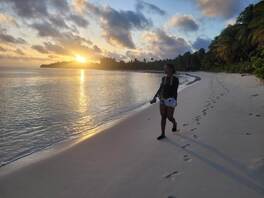 My recent trip to Desroches was not my first and I am hoping it will not be my last. Five years ago; in 2017, I was allowed to visit the island with the eco-school club whereby I and other students spent a week during the December holidays visiting and learning about the work that ICS, as well as IDC, does around the island. This year I was given the chance to return to the island as an intern with the Island Conservation Society and my experience has been a fruitful and enlightening one. Certain things were familiar while others were not as there have been a few changes that have occurred during the past five years, especially with the opening of the Four Seasons Hotel Desroches that was still under construction back then. Seasonality also played an important role in my most recent trip as the weather during the South East Trade Winds is not as kind as during the Northwest Monsoon. The weather was seldom on my side during my 7-week stay as I would find myself having to take out my raincoat whilst on the 11km or 9km turtle patrols on a fair amount of days and even on some occasions having to stop halfway due to bad weather. This was the major difference between my two experiences on the island as rough sea conditions prevented any marine-related activities. However, that did not prevent me from making the most out of my internship. I was able to work on my bird identification techniques as part of the morning patrols consisted of many sightings of different species. Some were new to me, while others were familiar from my previous internship with ICS on Aride Island last year. I am now able to identify certain key differences such as juveniles from adults, or for certain species those that are breeding and the non-breeding ones, as well as the distinct calls of the most recurrent species. Even now while being back on Mahe I get the thrill of knowing a particular species of bird when I see it flying by. The morning patrols were full of other interesting findings such as sightings of sea turtles, namely, Green Turtles that are currently in the breeding season which meant that there were lots of turtle tracks to be recorded as well as measured on the beach and also juvenile Hawksbill turtles swimming around close to shore. Sharks and rays were always the highlights of my mornings, however, as I would always get excited whenever I would see a pup or a new species of ray that I had not seen on previous patrols. Part of the internship also consisted greatly of taking care of juvenile Aldabra Giant Tortoises from hatchlings that are under 1kg to big juveniles ranging up to 9kg who are then released into the wild when they weigh beyond 9kg. These hatchlings are vulnerable to numerous threats such as predation from birds and rats, the vehicles on Desroches also pose a threat as the hatchlings may unintentionally get crushed due to their small sizes but it is also important to note that they are being protected from humans as well as small individuals are likely to get stolen to be sold off or to be kept as pets. Thus, the tortoise sanctuary is a safe space to ensure their growth and safety while ICS does their best to reduce possible threats through constant monitoring of rat and feral cat traps as well as the replenishment of rat poison among other methods of pest control. I find comfort in nature therefore island life is soothing and comforting due to the peacefulness of being in a serene and undisturbed environment. It does however have its disadvantages, because loving field work made me dislike being in the office, especially on rainy days whereby fieldwork was out of the question. Pursuing a career in conservation is and has been on my mind for some time as I am keen on not only playing a role in preserving and conserving the environment but also discovering and exploring the beauty hidden in most, if not all of Seychelles’ islands. However, it is surely not for everyone as it is far from the comforts of the Mahe life, far from entertainment and certain facilities depending on which island you go to. Special thank you goes out to ICS for this amazing opportunity and the IDC team on Desroches as well for all their help during the 7-week stay. I would surely encourage other nature lovers to venture into conservation and uncover nature’s secrets. The 10th annual Seychelles Sea Turtle Festival took place on Silhouette Island on Saturday, 20 August 2022. The Island Conservation Society (ICS), Hilton Labriz, the Island Academy, and Sea Turtle Friends of Seychelles (STFS) joined hands to create a phenomenal day for both adults and children. 2022 is the 10th Anniversary of the formation of Sea Turtle Friends of Seychelles, an NGO whose primary objective has been to organize the annual Sea Turtle Festival. The purpose of the Festival has been to raise awareness amongst children and their families about sea turtle natural history and the need to protect these wonderful, but endangered species. Sea turtles are an important part of the natural heritage of Seychelles and a great attraction for the thousands of tourists who visit Seychelles every year.
The day began with morning refreshments, followed by a turtle patrol, guided by the ICS Team led by Ms Nasreen Khan (ICS Conservation Officer, Silhouette) and Dr Jeanne Mortimer of STFS (also known as “Madamn Torti”) a turtle expert with 41 years of experience in Seychelles. The crowd learned what turtle conservation involves, including all the Do's and Don'ts when encountering sea turtle adults and hatchlings on the beach. Then the children moved on to the Hilton’s Kids Island Academy Centre where they engaged in face painting and took part in an “Amazing Race” that taught them about the natural environment within the Hilton Hotel grounds. After lunch, an energetic parade of children of all ages and adults made its way along the Silhouette roads adjacent to the hotel. The parade featured the Hilton Labriz Kids Train, with children riding inside its three cars. The children waved sea turtle posters that they had created during the previous week. They also shouted their enthusiasm for sea turtle protection while accompanied by the tunes “Baby Shark” and “Yellow Submarine” which were broadcast loudly from the first car of the train. Adults marched alongside the Kids Train in solidarity with the children, and the air was filled with a passion for the protection and conservation of endangered sea turtles. Legal protection was afforded to all sea turtles in Seychelles in 1994. Unfortunately, sea turtles within the inner granitic islands continue to face pressure from people who poach them for meat. Another threat is damage to foraging and nesting habitats in areas of poorly regulated coastal development. Educating the public about these issues and the importance of protecting sea turtles is crucial to conserving the sea turtle populations of Seychelles, which are a vital part of the marine ecosystem. Since its inception in 2013, Sea Turtle Friends of Seychelles has coordinated the Sea Turtle Festival every year. In the early years (2013-2017) it took place on Mahé, then on Praslin in 2018, and on La Digue in 2019. During 2020 and 2021 the Sea Turtle Festival was celebrated online due to Covid. “Now that Covid is in retreat, it is wonderful to see that Silhouette Island has revived the tradition in force! STFS is grateful to Hilton Labriz and Island Conservation Society (ICS) for hosting the event this year. We hope that the Seychelles Sea Turtle Festival will continue every year moving forward!” said Dr Mortimer. During November to December 2021 two researchers from the University of Oxford, in collaboration with SeyCCAT, the German Aerospace Agency, ICS, UniSey and other local entities/persons conducted extensive ground work around Mahe, Praslin, Desroches and D’Arros, these were under the ‘Seagrass Mapping and Carbon Assessment' project funded by the Pew Charitable Trusts. At this stage the main objective of the project has been to map the distribution of seagrass beds and to collect coring samples which will be used to calculate the amount of carbon stored in our seagrass meadows. The information gathered will help build the scientific baseline necessary for the Seychelles government to include the protection of seagrasses as a nature-based solution for our Nationally Determined Contributions (NDC). Nationally Determined Contributions - What are they?In December 2015, 196 parties adopted the Paris Agreement. This agreement includes commitments from all countries to reduce their emissions and to work together to adapt to the impacts of climate change. Its goal is to limit global warming to 1.5 to 2 degrees Celsius over pre-industrial levels. In November 2016 when the agreement came to force, it was a landmark achievement in the multilateral climate change process, being the first binding agreement bringing all nations into a common cause to combat climate change and adapt to its effects. Under the treaty, every 5 years, countries are required to submit their plans for domestic mitigation measures, also known as Nationally Determined Contribution (NDCs), which will be taken to reduce their greenhouse gas emissions and to build resilience to adapt to the impacts of rising temperatures, for climate change actions. Seychelles submitted its updated NDC in July 2021. For more information about the Paris Agreement follow the following link and see video below; What are Seychelles commitments to the NDC?"Blue carbon sinks" are habitats associated with the marine environment that they are known to store carbon. In other words, they are reservoirs that absorb more carbon than they release. Previously, the NDCs and Seychelles did not not include listings of blue carbon habitats in the national greenhouse emissions inventory. Quantifying our blue carbon sinks will help Seychelles to reach its commitments and targets. The 2021 NDC includes the following commitments and targets, focused on safeguarding the Blue Economy and Blue Carbon ecosystems, which are especially relevant to the ‘Seagrass Mapping and Carbon Assessment project’:
Seagrasses in SeychellesSeagrass meadows are perhaps the most under-appreciated marine habitats. In Seychelles, all marine plants including both 'Seagrasses' and 'Algae' share the name ‘Gomon’, although these are distinctly different types of marine plants (stay tune to the work being conducted by SeyCCAT’s Coastal Wetlands & Climate Change project to bring forward Creole names of our different seagrass species!). At least 10 species of seagrass have been identified in Seychelles. the following pictures compiled by SeyCCAT highlight some of the differences between the various species.. Importance of seagrass
Carbon stored in coastal and marine ecosystems is called Blue Carbon. Mangroves, tidal marshes and seagrass meadows sequester and store more carbon per unit area than terrestrial forests. For more resources on Blue Carbon click the link below for the downloadable document ‘COASTAL BLUE CARBON- Methods for assessing carbon stocks and emissions factors in mangroves, tidal salt marshes, and seagrass meadows’. Activities conducted so farSeagrass mapping and fieldwork training workshopDuring 26-29 October 2021, SeyCCATs’ Coastal Wetlands and Climate Change Project, in partnership with Oxford University, UniSey and BERI ran a 4 days’ workshop at the University of Seychelles. The participants were taught about blue carbon and its corresponding ecosystems, how to identify the seagrass species, and about the different methods that will be used to collect and analyse field data that will be used by the Oxford researchers. The workshop also included practical sessions whereby the participants mapped the seagrass distribution and collected core samples at Anse Royale- Bougainville region. FieldworkImmediately after the workshop the Oxford University team with local partners led a number of expeditions to collect data and soil cores around Mahe, Praslin, Desroches and D’Arros. The main aims of the expeditions were two-fold; - Conducting ground truthing exercises in order to accurately map the locations of seagrass meadow. This was done mostly by snorkeling or SCUBA diving teams, which conducted underwater photographic transects of the benthic zones while closely towing a GPS device at the surface. The data collected will be analysed relative to satellite images and used to accurately map the distribution of the seagrass meadows(and other undersea features). Another device used was the 'Drop Cam' or Tethered video recorder that was deployed in deeper waters, it involved pulling an underwater video camera from the boat to record characteristics of the substrates. - Collect soil cores at mapped sites. These sediment samples are sent to the laboratory where their density and organic carbon content are measured. *By quantifying the area of Seagrass distribution and the soil carbon content a first-time estimate of carbon stock for seagrass meadows in Seychelles will be generated. Here are some of the highlights from the field work conducted by the teams on Mahe, Praslin and DesrochesMahe (30th October- 7th November) Field work around Mahe (including the Ste Anne Marine Park) took about 9 days and had the participation of numerous organisations such as ICS, BERI and SPGA Praslin (9th November- 15th November)Field work around Praslin (including sites at La Digue) took 7 days Desroches (19th November- 26th November)Field work on Desroches consisted of a smaller team made up of ICS staff and the Oxford researchers only Why is Island Conservation Society involved? ICS is working closely with the Islands Development Company, and with particular reference to all the outer islands of Seychelles. The objectives of ICS are to conserve, restore and enhance island ecosystems and their associated marine environment in order to protect their natural and cultural assets. As many of the outer islands, support large seagrass communities, ICS is well positioned to provide the logistical and technical support needed to actualize the necessarily activities at these remote sites. ICS has completed the groundwork on Desroches Island and trained its staff to be able to undertake similar work for Cosmoledo, Farquhar , Alphonse and St. François. Stay Tune for more information on how the work progresses in February 2022. What’s next? The data collected will enable Seychelles to quantify its ‘blue carbon’ storage capacity and will provide the Government of Seychelles, with the information they need to update and include the protection of seagrass in their NDCs as a nature-based solution to climate change. AcknowledgementICS would like to take this opportunity to acknowledge and thank the whole team of partner organisations who have been active on the Seychelles Seagrass Mapping and Carbon Project, notably: the Pew Charitable Trusts, the Oxford University, the SeyCCAT Coastal Wetlands and Climate Change Project team, the Blue Economy Research Institute team from the University of Seychelles, IDC, the ICS island teams, SPGA, the Atoll divers and Octopus dive centers. Not forgetting the many individuals who participated in the research at one point. We look forward to seeing the fruit of the work we have done so far and look forward to your continued support to the continuation of this project. Below is a short video on the Seagrass outreach campaign led by SeyCCAT as part of the Coastal Wetlands and Climate Change Project supporting the Seagrass Mapping exercise and Carbon Assessment Project. Jean-Claude Camille, a Senior Conservation Ranger from Desroches, features in an online magazine article managed by Grand Luxury hotels. Jean-Claude shares an interesting story about his previous work experience and his dedication to the protection and promotion of the wonders of nature.
Click here to read more. |
Categories
All
Archives
June 2024
|



